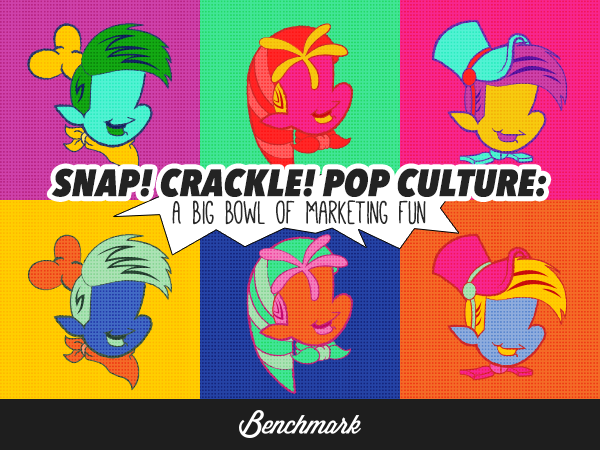Pop Culture Marketing: 5-Steps to Success for Companies Great and Small
July 23, 2014 3 min read

If asked a decade ago to comment on the potential for pop culture to increase sales and visibility in a marketing strategy, three things would have come to mind: mass media, big brands and big budgets. Since the mid 20th century, there are countless examples of pop culture marketing success stories involving product placement, endorsements and capitalization of brands with societal trends, sport, art and celebrities.
Pop culture is simply defined as “Commercial culture based on popular taste.”*
To illustrate this phenomena – a well placed Apple Mac in a thrilling moment in the latest Hollywood blockbuster, a pop star taking a swig of Coke during a live concert with screaming fans, tennis stars wearing Nike at Wimbledon, or even the latest Barbie doll reflecting the latest in fashion for young girls around the globe.
Is Pop Culture All About Big Brands?
Not anymore – nowadays, things have transformed. Pop culture marketing still encompasses all things big, however there are now unique opportunities for smaller players, on smaller budgets.
In a converged and globalized media environment, integration into a marketing strategy can be affordable and achievable to small business – with potential for mass influence and engagement.
Many marketers now view social media and digital marketing as forms of popular culture in their own right.
Opportunities to News Jack or News Lead
Due to technological ingenuity, pop culture now forms the omnipresent chicken and egg syndrome: lead or follow?
The speed at which pop culture is embraced, consumed and distributed (think viral) is as fast as its rejection and redundancy. In order to capitalize on an opportunity (news jacking) you may feel like it’s whizzed past before you’ve even blinked. In the reverse, the instigation of a pop culture campaign to increase awareness of your product or brand (news leading) also has its set of challenges.
Lead or follow, the great news about pop culture is that it never runs out. Nowadays there are some great tools available to get you started on developing your approach.
5-Steps to Get You Started
1. Brand Alignment
In order to link into a larger story in the media, you need to review how the trend supports your brand positioning. Opportunity needs to be balanced against alignment and potential backlash.
For example, if you owned an organic fruit store does your brand really align well with Game of Thrones? On the other hand, a link in with the World Cup to focus on healthy eating could be worth exploring.
2. Build a Following on Social Media
It sounds like an obvious statement, however I often come across small business owners who commence building their social media presence, only to become distracted, then things fall by the wayside.
Investing in your social media strategy not only provides you with brand presence and a conversation directly with your customers; the analytics generated can provide you with predictive value and behavioral patterns.
Tip: Better to be brilliant on a couple of social media platforms than have a substandard presence across the entire suite.
3. Real Time Marketing
Real time is a digital marketing technique that journeys huge cultural events as they happen. Hashtagging behavior and social media engagement during these events provide insight and, potentially predictions, for the next big pop culture trend.
By monitoring these trends – think blockbuster film releases, global sporting events even celebrity product endorsements, this can provide prognostics for pop culture marketing that can be tailored to your target market.
4. Crowdsourcing
Crowdsourcing is the process of obtaining needed services, ideas, or content by soliciting contributions from a large group of people, and especially from an online community, rather than from traditional employees or suppliers** Crowdsourcing again provides opportunities to news lead, or test an idea prior to going to market.
5. Investment of Your Time
Capitalizing on the latest pop culture trends in a cost effective and timely manner is an art. Regardless of whether you wish to lead or follow, it all boils down to time and timing. The benefits of weighing in on pop culture trends can be significant, yet the time investment to get it right can be as well.
It’s exciting times for pop culture marketing in the small business space. Now, due to digitalization, there are viable, plentiful and potentially profitable ways to tap into mass media to benefit your brand.






